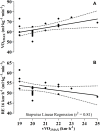Physiological Predictors of Maximal Incremental Running Performance
- PMID: 32848890
- PMCID: PMC7419685
- DOI: 10.3389/fphys.2020.00979
Physiological Predictors of Maximal Incremental Running Performance
Abstract
Purpose: The aim of this study was to verify whether physiological components [vertical jumps (Squat Jump - SJ and Countermovement Jump - CMJ), eccentric utilization ratio (EUR) of vertical jumps, running economy (RE), metabolic cost (C MET ), first and second ventilatory threshold (VT1 and VT2) maximal oxygen uptake (VO2MAX)] can predict maximal endurance running performance.
Methods: Twenty male runners performed maximal vertical jumps, submaximal running at constant speeds, and maximal incremental running test. Before, we measured anthropometric parameters (body mass and height) and registered the training history and volume. SJ and CMJ tests were evaluated prior to running tests. Initially, the oxygen uptake (VO2) was collected at rest in the orthostatic position for 6 min. Soon after, a 10-min warm-up was performed on the treadmill at 10 km⋅h-1, followed by two 5-min treadmill rectangular tests at 12 and 16 km⋅h-1 monitored by a gas analyzer. After that, the runners performed a maximal incremental test, where the VT1, VT2, and VO2MAX were evaluated, as well as the maximum running speed (vVO2MAX). Thus, RE and C MET were calculated with data obtained during rectangular running tests. Multivariate stepwise regression analyses were conducted to measure the relationship between independent variables (height and power of SJ and CMJ, EUR; RE and C MET 12 and 16 km⋅h-1 ; VT1, VT2, and VO2MAX), as predictors of maximal running performance (vVO2MAX), with significance level at α = 0.05.
Results: We found that VO2MAX and RE at 16 km⋅h-1 predict 81% of performance (vVO2MAX) of endurance runners (p < 0.001).
Conclusion: The main predictors of the maximal incremental running test performance were VO2MAX and RE.
Keywords: VO2MAX; incremental test; metabolic cost; runners; running economy.
Copyright © 2020 Lanferdini, Silva, Machado, Fischer and Peyré-Tartaruga.
Figures
Similar articles
-
Concurrent complex and endurance training for recreational marathon runners: Effects on neuromuscular and running performance.Eur J Sport Sci. 2021 Sep;21(9):1243-1253. doi: 10.1080/17461391.2020.1829080. Epub 2020 Oct 19. Eur J Sport Sci. 2021. PMID: 32981468
-
Moderate-Duration Dynamic Stretching During Warm-up Improves Running Economy and Running Performance in Recreational Distance Runners.Int J Sports Physiol Perform. 2024 Nov 28;20(1):99-108. doi: 10.1123/ijspp.2023-0468. Print 2025 Jan 1. Int J Sports Physiol Perform. 2024. PMID: 39608347 Clinical Trial.
-
Significance of the velocity at VO2max and time to exhaustion at this velocity.Sports Med. 1996 Aug;22(2):90-108. doi: 10.2165/00007256-199622020-00004. Sports Med. 1996. PMID: 8857705 Review.
-
Influence of Shoe Mass on Performance and Running Economy in Trained Runners.Front Physiol. 2020 Sep 23;11:573660. doi: 10.3389/fphys.2020.573660. eCollection 2020. Front Physiol. 2020. PMID: 33071828 Free PMC article.
-
Factors affecting running economy in trained distance runners.Sports Med. 2004;34(7):465-85. doi: 10.2165/00007256-200434070-00005. Sports Med. 2004. PMID: 15233599 Review.
Cited by
-
Triceps Surae Muscle-Tendon Properties as Determinants of the Metabolic Cost in Trained Long-Distance Runners.Front Physiol. 2022 Jan 4;12:767445. doi: 10.3389/fphys.2021.767445. eCollection 2021. Front Physiol. 2022. PMID: 35058793 Free PMC article.
-
Biomechanical, physiological and anthropometrical predictors of performance in recreational runners.PeerJ. 2024 Feb 26;12:e16940. doi: 10.7717/peerj.16940. eCollection 2024. PeerJ. 2024. PMID: 38426136 Free PMC article.
-
Modeling Physiological Predictors of Running Velocity for Endurance Athletes.J Clin Med. 2022 Nov 11;11(22):6688. doi: 10.3390/jcm11226688. J Clin Med. 2022. PMID: 36431165 Free PMC article.
-
Determinants of whole-body maximal aerobic performance in young male and female athletes: The roles of lower extremity muscle size, strength and power.PLoS One. 2022 Jan 12;17(1):e0262507. doi: 10.1371/journal.pone.0262507. eCollection 2022. PLoS One. 2022. PMID: 35020757 Free PMC article.
-
Enhancing instantaneous oxygen uptake estimation by non-linear model using cardio-pulmonary physiological and motion signals.Front Physiol. 2022 Aug 25;13:897412. doi: 10.3389/fphys.2022.897412. eCollection 2022. Front Physiol. 2022. PMID: 36105296 Free PMC article.
References
-
- Bassett D. R., Jr., Howley E. T. (2000). Limiting factors for maximum oxygen uptake and determinants of endurance performance. Med. Sci. Sports Exerc. 32 70–84. - PubMed
LinkOut - more resources
Full Text Sources
Miscellaneous



